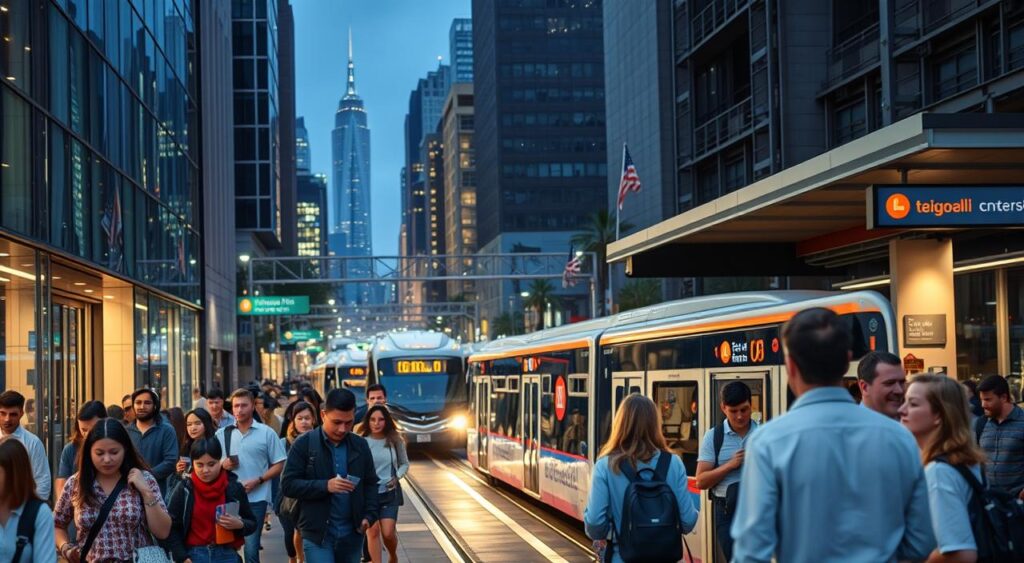Choosing the right local public transportation option, including bus service, can be tough. It’s about weighing transit passes against pay-per-ride fares. While some may choose to drive for convenience or flexibility, driving often comes with higher costs, parking hassles, and a greater environmental impact compared to public transit. Each choice offers benefits, depending on how often you travel, your budget, and your specific needs. Knowing more about these options will help you pick what’s best for your daily commute and lifestyle. For students, transit passes can also support participation in extracurricular activities by making it easier to get to and from school events.

This guide helps you decide between transit passes and pay-per-ride options for riders . You’ll learn how to weigh convenience, cost-effectiveness, and regular fare flexibility. The cost of public transit is often covered by a fare alongside tax subsidies or other sources of funding. All transportation modes, including roads, rails, buses, and air travel, require lots of financial resources for construction and ongoing maintenance, which is a major part of their overall costs. With these tips, you can find the perfect fit for your commuting needs and enjoy a better journey.
Key Takeaways
- Evaluate your commuting frequency to determine the best fare option.
- Consider your budget constraints to choose cost-effective solutions.
- Understand the convenience and flexibility benefits of each option.
- Align your transit choice with your lifestyle and daily needs.
- Explore both transit passes vs. pay-per-ride fares to make an informed decision.
Understanding Public Transit Passes
Public transit passes help regular travelers by offering ease, flexibility, and savings. Instead of buying a ticket each time with cash , you prepay for a set travel period. This way, you enjoy smooth rides without the ticket hassle.
Transit passes are intended for individual use and are typically non-transferable, ensuring that each pass is used by a single person as designed.
What Are Transit Passes?
A transit pass is a prepaid card for unlimited public transportation use during a specific time. You might choose a day, week, month, or year. Transit passes are great for those who travel often, unlike single fares, which cost per ride.
Types of Transit Passes
There are different transit passes available at stores for various needs.
The main types include:
- Monthly Passes: Best for everyday travelers, offering unlimited monthly travel.
- Weekly Passes: Good for regular commuters who don’t want a month-long commitment.
- Annual Passes: Ideal for those traveling all year, with the most savings.
- Day Passes: Great for tourists or rare users, allowing unlimited one-day travel.
Cost-Effectiveness of Passes
Transit passes save money compared to single ride fares. For example, Metro Lift cuts fares by half for those with SNAP benefits. They also make daily travel easier since there’s no need for cash, exact change, or daily tickets.
Some transit systems also offer loyalty programs where frequent riders can earn free trips or other benefits.
When weighing transit cards against single fares, the regular fare passes clearly win. They save frequent travelers time and money and are easier to use.
Exploring Pay-Per-Ride Options
When looking at public transit, pay-per-ride choices stand out. They work great for people who don’t travel every day. This way, you pay only for the trips you make. In some systems, pay-per-ride fares are divided by zones or distance, so the total cost of each trip depends on how far you travel or which zones you cross. This can save a lot of money.

Purchasing and Using Transit Passes
Getting started with a transit pass is simple and convenient, whether you’re a daily commuter or an occasional rider. Most local transit systems make it easy to purchase a pass through your smartphone at fits your travel needs and budget.
You can buy a transit pass at local transit stations, from vending machines, or even online through the transit system’s website or mobile app. Payment is flexible—use cash, debit cards, or other accepted methods to purchase your pass. Many riders appreciate the convenience of vending machines, which are available at major stations and allow you to buy or reload your pass at any time.
A monthly pass is a popular choice for those who use local buses and trains frequently. With a monthly pass, you get unlimited rides for a fixed cost, making it easy to budget for your daily commute to school . If you only need to travel occasionally, you can opt for a single-ride ticket or a daily pass, giving you the flexibility to pay only for the days you travel.
Using your transit pass is straightforward. Simply tap your card on the fare validator at vending machines or show your pass to the bus driver when you board. This ensures you receive free transfers between buses and trains, so you can reach your destination without paying extra fares. Some systems also offer a pay-as-you-go option, where you load funds onto your card and pay for each ride individually—perfect for those who want more control over their spending.
Transit passes are sold at a variety of locations, including stations, vending machines, and select retail stores. You can also buy or reload your pass online, making it easy to manage your travel funds from anywhere. Availability of passes may vary by location, and some passes are only sold at specific places such as schools or authorized retailers. Whether you’re a student, a business professional, or just exploring the city, there’s a pass option designed to make your journey smoother and more affordable.
Where to Buy: Retail Locations for Passes
Purchasing a transit pass in your city is easy and convenient, thanks to a wide range of retail locations. You can buy passes at vending machines located in subway stations, which are open during transit hours and accept both cash and debit cards. Many local businesses, such as convenience stores and newsstands, also sell transit passes—just look for the “Transit Passes Sold Here” sign in the window. If you’re a student, check with your school or university, as many campuses offer student passes for purchase right on site.
For added convenience, you can also buy passes online through the transit authority’s website or at select authorized retailers throughout the city. When planning your purchase, it’s essential to check which locations offer the specific pass you need, as not all stores or vending machines may carry every type of pass. Whether you’re looking for a monthly pass, a student pass, or a single-ride ticket, there’s a retail option nearby to make your transit experience as smooth as possible.
How to Use Transit Passes
Using your transit pass is simple and designed to make your travel experience hassle-free. After you purchase your pass from a retail location or online, you can use it to pay your regular fare on local buses, trains, and other transit services. For most passes, just tap your card or pass on the fare validator as you board the bus or enter the train station. If you’re using a mobile ticketing app, you can show your ticket on your smartphone to the bus driver or fare inspector.
Many passes, such as the monthly pass, offer unlimited rides, so you can travel as often as you like without worrying about the cost of each ride. Free transfers are often included, allowing you to switch between local buses and trains without paying extra fares. Be sure to check the details of your pass to understand its specific benefits and any restrictions, such as which services are covered or how long the pass is valid. With a transit pass, you’ll enjoy the convenience of easy payment, free transfers, and unlimited access to your city’s transit network.
Special Fare Programs and Payment Options
Many transit systems offer special fare programs to make public transportation more accessible and affordable for everyone. If you’re a student, senior, or meet certain income requirements, you may be eligible for discounted fares or even free rides on local buses and trains.
For students, college passes are a great way to save money. These passes provide unlimited rides at a reduced cost and can often be purchased directly through your college or university. To qualify, you’ll usually need to show a valid student ID or proof of enrollment. Similarly, seniors and people with disabilities can access special programs that offer lower fares—just provide the necessary documentation, such as income verification or a benefits card, when you purchase your pass.
Paying for your fare is easier than ever, thanks to a variety of payment options. You can use cash, debit cards, credit cards, or even your smartphone to buy and manage your transit pass. Many transit systems have mobile apps that let you purchase passes, load funds, and track your travel history right from your phone. This makes it simple to keep your card loaded and ready for your next ride.
Special fare programs often come with extra benefits, such as free transfers or unlimited rides within a certain period, making them a smart choice for frequent riders. Just remember to follow the transit system’s guidelines—tap your card on the fare validator or show your pass to the driver to ensure you receive your discount.
To find out which special fare programs and payment options are available in your region, visit your local transit system’s website or contact their customer service department. They can provide details on eligibility, costs, and how to apply, so you can make the most of your public transit experience.
Student and College Passes
Student and college passes are a smart, budget-friendly option for students who rely on public transportation to get around town or commute to school. These passes typically offer unlimited rides on local buses and trains for a set period, such as a month, at a reduced cost compared to regular fares. To be eligible, you usually need to be enrolled at a participating school or college, and you may need to show your student ID or proof of enrollment when you purchase or use the pass.
You can purchase student and college passes on campus, at select retail locations, or through your school’s transportation office. The cost of these passes varies by region and program, but they are often significantly lower than standard monthly passes, helping students save money while maintaining easy access to essential transit services. If you’re a student looking for a convenient and affordable way to travel, a student or college pass is an excellent option to consider.
Transit Assistance Programs
Transit assistance programs are designed to make public transportation more accessible and affordable for those who need it most. These programs offer discounted fares, free passes, or other forms of support to eligible riders, such as low-income individuals or people with disabilities. To qualify, you’ll typically need to meet certain income or disability requirements and may need to provide documentation, such as proof of income or a doctor’s note.
You can apply for transit assistance programs through your local transit agency or a partnering social services organization. Once approved, you’ll receive access to reduced-cost fares or free passes, making it easier to reach essential destinations like work, school, or medical appointments. These programs are a vital resource for ensuring everyone in the community can benefit from reliable transit services, regardless of their financial situation.
Mobile Ticketing Apps
Mobile ticketing apps are revolutionizing the way riders pay for and access public transit. With these apps, you can purchase and store your bus or train tickets directly on your smartphone, eliminating the need for cash or physical tickets. Simply download the app, create an account, and use your debit card or another accepted payment method to buy tickets or passes. Many apps also offer features like route planning, real-time service updates, and easy access to your travel history.
When it’s time to ride, just show your ticket on your phone to the bus driver or tap your smartphone at the fare validator. Mobile ticketing is an easy, convenient option for anyone looking to streamline their transit experience and reduce reliance on cash or paper tickets. With more transit agencies offering mobile ticketing every day, it’s never been simpler to buy, store, and use your transit passes and tickets—all from the palm of your hand.
How Pay-Per-Ride Works
Pay-per-ride systems are easy to use. Pay-per-ride tickets or tokens can be obtained at stations, vending machines, or through mobile apps. You buy a ticket or token each time you need to go somewhere. It’s simpler than buying a pass that needs a lot of money and commitment upfront. You can use a card or phone app for easy access to buses and trains.
Pricing Models for Pay-Per-Ride
There are different ways to price pay-per-ride services:
- Flat Rate – One price per trip, no matter the distance.
- Distance-Based Fare – The cost changes based on how far you go.
- Time-Based Fare – Prices can change depending on when you travel, with different rates for busy and quiet times. Some pay-per-ride tickets are valid for a set number of hours, allowing free transfers within that period.
These options can fit many travel needs. They make pay-per-ride good for all kinds of travelers.
Benefits of Pay-Per-Ride
Pay-per-ride lets you pay only for what you use, and you might be eligible for discounts . This can lead to big savings, especially if you don’t travel much. It’s also perfect for last-minute plans. You can pick from different transit options without worrying about using a pass before it expires. Plus, with no expiration dates, you’re not forced to travel just to get your money’s worth.
Comparing Costs: Passes vs. Pay-Per-Ride
Choosing between public transit passes or pay-per-ride options for your business takes careful thought. You need to consider if you’re using it short-term versus long-term. Also, think about your daily costs and any sneaky fees. Let’s explore these points to figure out the best option for you.
The result of choosing a pass versus pay-per-ride can significantly affect your overall savings and influence your transit usage patterns.
Short-Term vs. Long-Term Use
Pay-per-ride may seem cheaper for short trips. But, the cost adds up if you ride often. For those using transit regularly, passes save money by offering discounts and setting spending caps.
Daily Commute Costs
Daily commuters need to look at monthly costs. Pay-per-ride charges you each trip, which can get expensive. But, a transit pass means unlimited rides at one set price, saving money every day.
Hidden Fees and Extras
It’s important to check for hidden costs in both options. Transit passes might have one-time fees, while pay-per-ride could have extra charges like service fees. Knowing these can help you pick the most wallet-friendly choice.
| Criteria | Transit Pass | Pay-Per-Ride |
| Upfront Cost | Yes (varies by duration) | No |
| Daily Expense | Fixed | Variable |
| Hidden Fees | Possibly (activation fees) | Yes (minimum balance) |
| Long-Term Savings | High | Low |
Frequency of Travel and Its Impact
Knowing how often you travel helps choose between transit passes and pay-per-ride. Each traveler has a different schedule that affects the benefits of transit passes and savings for commuters.
Occasional Users
For those who don’t travel much, pay-per-ride is cheaper. If your trips are rare, a transit pass might not be worth it. By looking at how often you travel, you can save money and avoid extra costs.
Daily Commuters
Daily commuters, including students, gain a lot from transit passes. Many schools partner with transit agencies to provide passes for students, making daily commuting easier. Using public transit every day for work or school means a monthly or yearly pass could save you a lot. These passes allow unlimited rides for a certain time, perfect for regular commuters.

Weekend Travelers
Weekend travelers have different needs. If public transit is your go-to on weekends, paying per ride could work better unless you travel enough for a weekend pass. Some places offer weekend-only passes that could help save money.
| Traveler Type | Recommended Option | Potential Savings |
| Occasional Users | Pay-Per-Ride | Cost-effective for infrequent trips |
| Daily Commuters | Transit Passes | Substantial commuter savings with frequent travel |
| Weekend Travelers | Pay-Per-Ride / Weekend Passes | Cost-effective for limited weekend travel |
Convenience Factor: Passes vs. Pay-Per-Ride
Choosing whether to purchase a transit card or single fare is a big deal. It really can change how you view daily travel. Each way has its perks that could sway your choice.
For added convenience, riders can open the transit app to purchase tickets or check schedules, making it easier to plan their trips.
Ease of Use
Pay-per-ride is super easy, thanks to new tech like tap-and-go on phones. You can use a smartphone or a special card for a smooth ride. This method is perfect for folks who prize speed and simplicity.
Accessibility Across Different Transit Systems
It’s key to think about how well these payment ways work on many transit lines and how they are shown on maps . Choosing between a transit card or single fare often means looking at how they fit with different systems. Some cities have payment systems that work everywhere, making things easier.
Pay-per-ride shines when you’re moving across areas. It cuts down on the trouble of keeping track of many tickets. Looking at ease of use, each payment method is best in certain situations.
For more detailed information on payment options, transfer policies, and discount eligibility, visit the transit authority’s fare page.
Exploring the City with Public Transit
Public transit is an essential tool for exploring any city, whether you’re a resident or a visitor. With a robust network of bus service, local buses, subways, and trains, you can access every corner of the city without the hassle of driving or parking. These services are designed to make getting around easy, affordable, and efficient, connecting neighborhoods, business districts, and popular attractions.
For those who plan to travel frequently, a monthly pass is a smart investment. With a monthly pass, you enjoy unlimited rides and free transfers on local buses and trains, making it simple to hop from one destination to another. This not only saves money but also adds convenience, as you won’t need to worry about paying for each individual ride. Whether you’re commuting to work, running errands, or discovering new parts of town, public transit provides the access and flexibility you need to make the most of city life.
Sightseeing and Tourist-Friendly Options
If you’re visiting a new city, public transit offers a budget-friendly and convenient way to see the sights. Many transit systems provide special sightseeing passes that grant unlimited rides on local buses and trains, giving you the freedom to explore at your own pace. These passes often include access to top attractions and can be purchased easily at vending machines, online, or even loaded onto your smartphone or card for quick use.
With a sightseeing pass, you can enjoy unlimited rides throughout your stay, making it easy to visit museums, parks, and other must-see destinations without worrying about individual fares. The convenience of using local buses and trains means you can travel like a local, avoid traffic, and make the most of your time in the city. Plus, with free transfers included, you can switch between buses and trains seamlessly, ensuring your sightseeing adventure is both easy and enjoyable.
Maximizing Value for Visitors
To get the most out of your public transit experience as a visitor, look for passes that offer access to multiple modes of transportation, such as buses and trains. A monthly pass or a special visitor pass often includes unlimited rides and free transfers, allowing you to travel across the city without extra costs. This is especially useful if you plan to visit several attractions or need to move between different neighborhoods.
Many cities also offer special discounts or promotions for visitors, such as reduced fares or free admission to select attractions when you purchase a transit pass. To find the best deals, check the transit authority’s website or stop by a local station for up-to-date information on available passes and services. With the right pass, you’ll enjoy easy access to all the city has to offer, making your trip both affordable and stress-free.
FAQ
What are transit passes and how do they work?
Transit passes let you ride public transportation as much as you want for a set time. This could be a month, week, or year. They’re a good deal if you ride buses or trains often.
What types of transit passes are available?
You can get monthly, weekly, or yearly transit passes. There are also special deals. For example, students, seniors, and those with lower incomes can save money. The Metro Lift program even offers half-price fares for people getting SNAP benefits.
How is pay-per-ride different from transit passes?
Pay-per-ride means you pay for each trip separately. This is more flexible if you don’t travel often. You might pay a set price or more for longer trips, depending on the system.
What are the benefits of choosing a transit pass over pay-per-ride?
With a transit pass, you don’t have to think about the cost of each ride. It’s especially handy and cheaper for people who use public transportation every day.
How does the frequency of travel affect whether you should choose a transit pass or pay-per-ride?
A transit pass is better if you ride frequently, saving you money and hassle. If you don’t travel much, pay-per-ride could be cheaper since you only pay for the trips you make.
Are there hidden costs associated with transit passes or pay-per-ride options?
There might be extra fees like activation charges or a minimum card balance. Always check the details to avoid surprises.
Which option provides more flexibility for changing travel plans?
Pay-per-ride is more flexible, allowing you to change your travel plans easily. Transit passes are for specific areas or routes, which might not suit everyone’s needs.

How does the convenience of use compare between transit passes and pay-per-ride?
Both offer easy use, like tapping your phone to ride. But a transit pass means you don’t need to pay for each trip. So, it’s quicker when you’re commuting.
How do transit options differ between urban and rural areas?
In cities, you have more public transportation choices, so a pass might work better. In rural places, with fewer options, paying for each trip can make more sense.
What environmental benefits do public transportation fare choices offer?
Public transport is better for the planet than driving alone, especially when it offers free options . If more people choose transit passes, it could lead to more regular use and fewer car trips.
What questions should I consider before deciding on a public transit option?
Think about how often you travel, your budget, if you need travel flexibility, how you can use debit cards and what’s available where you live. These questions can help you choose the best option for your situation.


